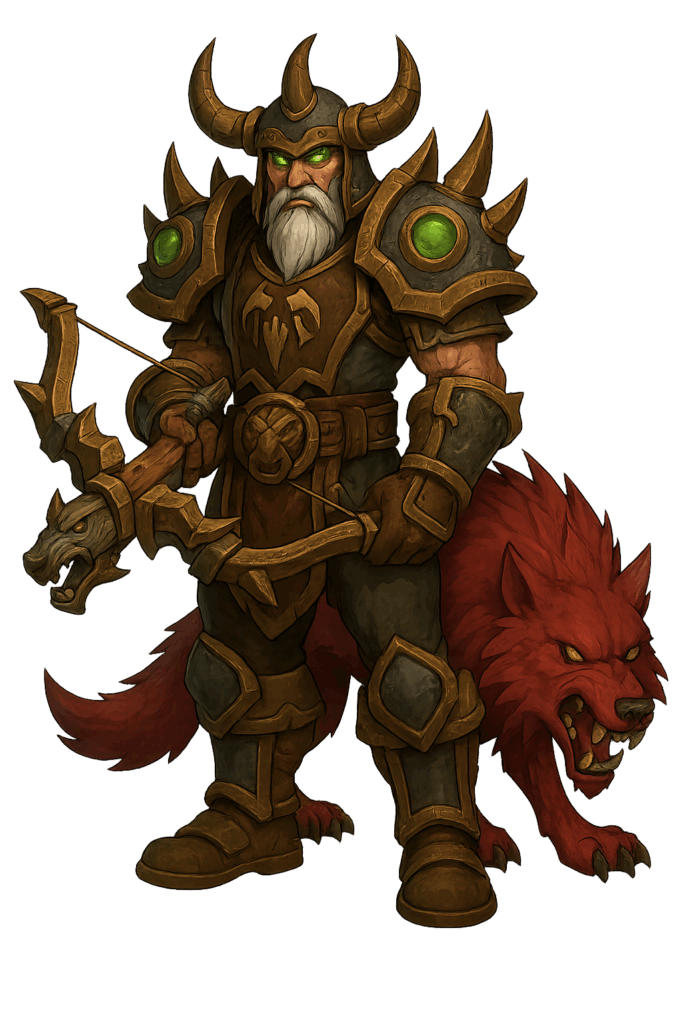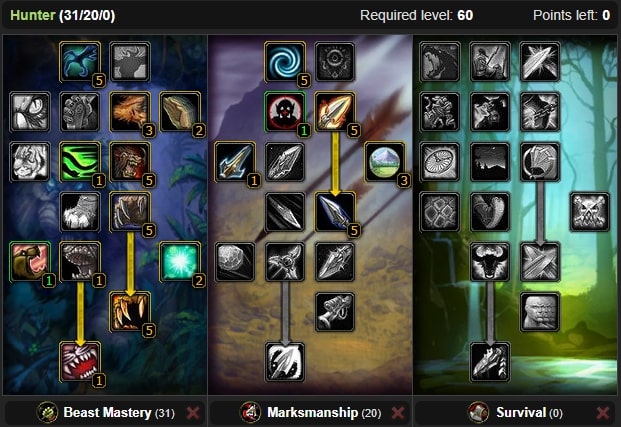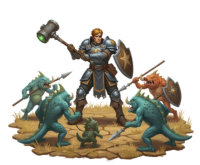Welcome to the definitive Beast Mastery Hunter PvP guide for WoW Classic. While Marksmanship may dominate raid meters, Beast Mastery brings unique strengths to player-versus-player combat that make it a formidable force in battlegrounds, duels, and open-world encounters. This guide covers everything from talent optimization to advanced kiting mechanics that separate good hunters from legendary ones.
Beast Mastery shines in PvP through its signature ability Bestial Wrath—a game-changing cooldown that makes your pet immune to crowd control while dramatically increasing its damage. Combined with Intimidation for on-demand stuns and superior pet survivability, this specialization excels at applying relentless pressure while your companion tears through enemy lines.
For players seeking different hunter approaches to PvP, explore our guides for Marksmanship PvP and Survival PvP, or check the main Hunter Guide hub for comprehensive class information.
Why Choose Beast Mastery for PvP?
Understanding Beast Mastery’s role in PvP environments helps you leverage its strengths and mitigate weaknesses.
Core Advantages
Bestial Wrath Immunity: Your 18-second window of power grants your pet complete crowd control immunity. While Mages freeze warriors and Priests fear rogues, your pet continues attacking uninterrupted, creating consistent pressure that forces defensive cooldowns.
Superior Pet Survivability: Beast Mastery talents heavily invest in pet health, damage reduction, and healing effectiveness. Your pet becomes significantly harder to kill compared to other hunter specs, ensuring your primary damage source stays active throughout extended fights.
Intimidation Stun: This 3-second stun on a 1-minute cooldown provides essential crowd control for setting up burst damage, interrupting critical casts, or creating distance from melee attackers. Unlike many stuns, Intimidation works through your pet at range.
Strong Against Casters: The combination of ranged pressure, pet-based interrupts, and Bestial Wrath’s immunity to polymorph and fear makes Beast Mastery particularly effective against caster classes who rely heavily on crowd control.
Limitations in PvP
Your personal burst damage is lower than Marksmanship hunters, making it harder to secure kills quickly against skilled opponents. You’re heavily dependent on pet survival—if your pet dies repeatedly, your damage output plummets. Additionally, enemy players can specifically target and kill your pet, unlike in PvE where pets primarily tank NPCs.
Area-of-effect damage poses challenges, as your pet can easily be caught in cleave damage or AoE abilities. You’ll need excellent pet control to minimize these situations.
Race Selection for PvP Dominance
Racial abilities impact PvP performance more significantly than PvE, as active abilities provide crucial outplay potential.
Horde Recommendations
Orc (Best Overall): Command‘s +5% pet damage directly amplifies your primary damage source. While the benefit is smaller than in PvE, it remains consistent value. More importantly, Hardiness provides +25% stun resistance—an incredible defensive racial that helps you avoid control from rogues, warriors, and paladins. Blood Fury doesn’t benefit hunters (melee AP only), but the stun resistance alone makes Orcs competitive.
Troll (Excellent Alternative): Berserking is phenomenal for PvP burst windows. The attack speed increase synergizes perfectly with Bestial Wrath, creating devastating damage spikes. Bow Specialization (+5 weapon skill) helps ensure your shots land against higher-level opponents. Trolls trade pet damage for superior personal burst potential.
Tauren (Defensive Choice): War Stomp provides an AoE stun on a 2-minute cooldown—incredible for creating space against multiple melee attackers or interrupting nearby casters. Endurance increases total health for better survivability. Tauren excel in battlegrounds where group fights are common.
Alliance Options
Dwarf (Recommended): Stoneform is exceptional for PvP. It removes bleeds, poisons, and diseases while reducing physical damage by 10%. This ability hard-counters rogues (removes poisons and bleeds) and provides valuable damage reduction against warriors. Gun Specialization (+5 weapon skill) ensures hit chance consistency.
Night Elf (Situational): Shadowmeld has niche applications for escaping combat or setting up ambushes, but it doesn’t work in combat and provides limited value during active fights. The highest base Agility offers marginal damage benefits. Night Elves are aesthetically appealing but mechanically weaker for PvP.
For leveling strategies with your chosen race, visit our Beast Mastery Leveling Guide.
Talent Builds: PvP Optimization
Unlike PvE’s relatively rigid talent structures, PvP offers flexibility based on playstyle preferences and battleground versus dueling focus.
This build sacrifices burst damage for defensive survivability and enhanced trap control. The Entrapment synergy with Frost Trap creates a nearly inescapable slow zone, while Deterrence provides a powerful defensive cooldown against melee classes.
For talent experimentation, use our Hunter Talent Calculator to test different configurations.
Pet Selection: Your Combat Partner
Your pet choice significantly impacts PvP effectiveness. Unlike PvE’s wolf supremacy, PvP demands flexibility based on matchup and situation.
Best PvP Pets
Cat (Best for Burst Damage): Cats attack extremely fast (1.0 attack speed), generating consistent Frenzy procs and maximizing Intimidation stun availability. Their Prowl ability allows repositioning without drawing attention. Recommended pet for aggressive playstyles and securing kills quickly.
Wind Serpent (Ranged Harassment): Lightning Breath provides ranged Nature damage, allowing your pet to contribute even when kited away from melee range. Excellent against casters and for applying pressure at range. The ranged attack keeps enemy healers in combat, preventing drinking.
Scorpid (Crowd Control Utility): Scorpion Sting applies a nature damage DoT, but more importantly, it provides an alternative to Serpent Sting that doesn’t break crowd control. You can maintain a sting on the target without damaging it during crowd control, keeping it in combat.
Boar (Defensive Option): Charge ability helps pets reach targets quickly, and boars have moderate survivability. Useful for battlegrounds where pets frequently need to close distance gaps.
| Pet Family | Attack Speed | Armor Type | Best Use Case |
|---|---|---|---|
| Cat | 1.0 (Fast) | Leather | Burst damage, frequent stuns |
| Wind Serpent | 1.0 (Fast) | Leather | Ranged harassment, anti-caster |
| Scorpid | 1.2 (Average) | Carapace | Utility, CC maintenance |
| Boar | 2.0 (Slow) | Leather | Gap closing, moderate defense |
| Wolf | 1.3 (Average) | Leather | Balanced option |
For complete pet taming locations and ability training, reference our Hunter Pets Guide.
Stat Priority and Gear Selection for PvP Beast Mastery
PvP stat priorities differ from PvE due to the importance of survivability and hit chance against players.
PvP Stat Priority
- Hit Rating to 5%: Player targets require only 5% hit (not the 9% needed for raid bosses). Prioritize reaching this cap first to ensure your abilities land consistently.
- Resilience (If available in your Classic version): Reduces critical strike damage taken and chance to be critically hit—directly counters burst damage.
- Agility: Provides Ranged Attack Power, critical strike chance, and dodge chance. Triple benefit makes it extremely valuable for PvP.
- Stamina: Health pools determine survival against burst. More health provides more reaction time to use defensive cooldowns or receive heals.
- Ranged Attack Power: Direct damage increase after Agility is prioritized.
- Intellect: Mana sustain matters in extended battleground fights where drinking isn’t always possible.
Recommended Gear Pieces
Prioritize PvP Sets: The blue PvP reputation sets offer excellent stat distributions for hunters, with emphasis on stamina and balanced offensive stats.
Weapon Enchants: Scope your ranged weapon with +7 damage or +3% hit depending on current hit rating.
Armor Kits: Use Agility enchants on most armor pieces for maximum offensive/defensive benefit.
For optimal PvP gear loadouts, consult our Hunter Pre-Raid BiS Guide which includes PvP gear recommendations.
Consumables and Engineering
Proper consumable usage dramatically increases your PvP success rate, especially in competitive battlegrounds or organized world PvP.
Essential Consumables
Health and Mana Management:
- Major Healing Potion: Instant 1,500 health (2-minute cooldown)
- Major Mana Potion: Restores ~1,750 mana (2-minute cooldown)
- Heavy Runecloth Bandage: 2,000 healing over 8 seconds (combat bandaging)
Combat Enhancers:
- Elixir of the Mongoose: +25 Agility, +2% Critical Strike (1 hour)
- Juju Might: +40 Attack Power (pet benefits)
- Free Action Potion: Immunity to movement impairment and loss of control (30 seconds)
- Living Action Potion: Frees from movement impairment effects (5 seconds)
- Swiftness Potion: +50% movement speed (15 seconds)
Specialized Potions:
- Limited Invulnerability Potion (LIP): Physical immunity for 6 seconds (crucial against melee)
- Invisibility Potion: Stealth for 18 seconds (escape or repositioning)
- Noggenfogger Elixir: Shrink effect makes you harder to target and click
Engineering: The PvP Profession
Engineering provides game-changing advantages for PvP:
Combat Items:
- Thorium Grenade: AoE stun (2-second disorient)
- Goblin Sapper Charge: AoE damage and knockback
- Dense Dynamite: High damage explosive
- Iron Grenade: Lower level AoE damage option
Utility Devices:
- Arcanite Dragonling: Summons pet for additional damage
- Gnomish Net-o-Matic: Roots target in place (30-second cooldown)
- Goblin Rocket Boots: Speed burst for escaping or chasing (5-minute cooldown)
Engineering also provides self-crafted Thorium ammunition, essential for consistent damage output without purchasing expensive ammo.
Explore every bomb, trinket, and schematic in our WoW Classic Engineering Guide.
Combat Strategies: Kiting and Positioning
Mastering hunter PvP requires understanding optimal positioning and movement patterns against each class archetype.
Fighting Melee Classes
Melee opponents represent your biggest threat if they reach you consistently. Your goal: maintain 20-35 yard distance at all times.
Kiting Fundamentals:
Keep targets perpetually slowed with Concussive Shot. Use this ability on cooldown, as the slow prevents melee classes from reaching you. Improved Concussive Shot’s 4-second daze is devastating—affected players cannot sprint, charge, or use gap closers.
Dead Zone Awareness: The 5-8 yard range where you cannot use ranged attacks is your most vulnerable position. If enemies enter this zone:
- Immediately Wing Clip the target
- Use Aspect of the Cheetah to create distance quickly
- Switch to Aspect of the Hawk once safe distance is established
- Resume shooting while moving backwards
Freezing Trap Technique: Your most powerful tool against melee. Since Freezing Trap can’t be placed in combat, use Feign Death to drop combat, then immediately place the trap on top of your opponent. With practice, this becomes nearly guaranteed, freezing them for 20 seconds and allowing full reset.
Against Warriors: Warriors have multiple gap closers (Charge, Intercept) and can hamstring you. Save Freezing Trap specifically for after they use both charges. Use Scatter Shot when they reach you to create space. Deterrence (if talented) completely negates their damage for 10 seconds.
Against Rogues: Track Hidden and Flare reveal stealthed rogues before they engage. If caught in a stun, use Bestial Wrath after the stun ends—your pet becomes immune to Blind, Sap, and Gouge, ensuring continued damage. Target the rogue immediately when they Vanish and use Flare in their escape direction to reveal them again.
Fighting Casters
Casters challenge your positioning skills—stay at maximum range while avoiding their casts.
Maximum Range Advantage: Hawk Eye gives you 41-yard range compared to most casters’ 36 yards. Use this 5-yard buffer to shoot them while staying outside their cast range. Move back immediately when they approach the 36-yard threshold.
Predictive Movement: Watch cast bars closely. Begin moving just before Polymorph or Fear completes, forcing wasted casts. Time your movements to minimize lost auto attacks.
Scatter Shot Burst: Open with Scatter Shot (4-second incapacitate) → Aimed Shot → Auto Shot → Multi-Shot. This burst combo deals massive damage while they cannot respond. Scatter Shot hits instantly, making it difficult to counter.
Viper Sting Dominance: Apply Viper Sting immediately against all mana users. This ability drains 460 mana over 8 seconds, rapidly depleting their resource pool. Keep it active permanently. Once they reach zero mana, they become helpless—finish them with ranged attacks while they cannot cast.
Against Mages: Mages are your hardest caster matchup due to Blink. Stay at maximum range and bait Blink before committing to burst. Use Feign Death to cancel their cast if you’re too close when they start Polymorph. After they Blink, chase aggressively before they create distance again.
Against Warlocks: Fear is their primary defense. Use Bestial Wrath when engaging—your pet becomes immune to Fear, maintaining pressure. Use Intimidation to interrupt critical casts like Fear or Shadowbolt. Viper Sting heavily impacts their mana pool since most of their abilities cost significant mana.
Advanced Techniques and Tricks
Separating skilled Beast Mastery hunters from average ones requires mastering these advanced mechanics.
Feign Death Applications
Beyond dropping combat for traps, Feign Death provides multiple tactical advantages:
Cast Interruption: If an enemy begins casting a dangerous spell (Polymorph, Fear, Frost Bolt), Feign Death before it completes. Their cast will fail as they lose their target, wasting their cast time and mana.
Threat Reset: In world PvP with multiple enemies, Feign Death drops you from threat tables, causing enemies to switch targets. Use this when overwhelmed to allow repositioning or escape.
Trap Placement Under You: Feign Death → Place trap on your location → Stand up. If enemies reach your position, they trigger the trap immediately. Particularly effective with Freezing Trap when you expect incoming melee.
Pet Micro-management
Pet Passive Control: Advanced players keep pets on Passive permanently, manually commanding every attack. This prevents:
- Pet running into AoE
- Pet attacking crowd-controlled targets
- Pet revealing your Feign Death
- Pet getting baited away from important targets
Pet Sacrifice: If your pet is at 10% health and being focused, dismiss it before it dies. Resummon a new pet at full health instantly (3-second cast) rather than using Revive Pet mid-combat (10-second cast). This technique maintains pet uptime during critical moments.
Pet Body Blocking: Position your pet between you and charging enemies. While pets won’t physically block movement in Classic, they can obstruct player vision and clicking, especially in chaotic battles.
Aspect Dancing
Swap Aspects based on immediate needs:
Aspect of the Cheetah: Use when no one can attack you (running between objectives, escaping after Freezing Trap). The 30% movement speed dramatically improves mobility but causes daze when hit.
Aspect of the Hawk: Combat stance for ranged attack power. Use during active engagement.
Aspect of the Monkey: Situationally useful in melee range for dodge chance, but generally avoided since you shouldn’t stay in melee.
For additional macro setups to streamline these techniques, visit our Hunter Macros Guide.
Battleground-Specific Strategies
Different battlegrounds require adapted strategies to maximize contribution.
Warsong Gulch (Flag Capture)
Flag Carrier Support: Use Concussive Shot on enemy defenders chasing your flag carrier. Your long range allows you to slow enemies without putting yourself at risk. Position between your carrier and pursuers.
Flag Room Defense: Place Frost Trap at flag spawn point. Entrapment talent (if taken) creates a rooting zone that traps enemy flag carriers. Camp the flag from mid-field range, shooting anyone who enters the room.
Carrier Harassment: Your mobility and range excel at chasing enemy flag carriers. Maintain Concussive Shot uptime and use Bestial Wrath when bursting the carrier down.
Alterac Valley (Large-Scale Battle)
Tower/Bunker Assault: Summon a pet that can Charge (boar) or has high mobility. Send it ahead to pull defenders and disrupt their positioning. Your pet becomes a nuisance that demands attention while you attack from range.
Defense Positioning: Position on elevated terrain near objectives. Your range advantage lets you attack enemies below while remaining difficult to reach. Use traps on access paths to control enemy movement.
Mine Resources: Solo capping mines is efficient as a hunter. Use track Humanoids to detect incoming enemies early and Feign Death if overwhelmed.
Arathi Basin (Resource Control)
Point Defense: Position centrally near your controlled point. Track Humanoids reveals incoming attackers. Place Frost Trap at the flag, then position yourself at range. Attackers must either trigger the trap or take an inefficient path.
Solo Capping: Send your pet to begin flag captures while you provide ranged cover. The pet can continue channeling while you fight off defenders. Your DPS and pet survivability make you excellent at contesting points 1v1 or even 1v2.
Rotating Points: Your mobility allows quick rotation between points. Use Aspect of the Cheetah when traveling between bases to respond to threats faster than most classes.
Beast Mastery Hunter PvP FAQ
Is Beast Mastery good for PvP in WoW Classic?
What makes Beast Mastery strong in PvP?
What are Beast Mastery’s main PvP weaknesses?
Best PvP talent build for Beast Mastery?
Which race is best for BM Hunter PvP?
Best pets for Beast Mastery in PvP?
How should I manage my pet in PvP?
What is the PvP stat priority for BM Hunters?
Must-have consumables for BM PvP?
Why is Engineering so good for Hunter PvP?
How do I fight melee classes as BM?
How do I fight caster classes as BM?
When should I use Bestial Wrath in PvP?
What are common BM PvP mistakes to avoid?
Battleground tips for BM (WSG/AB/AV)?
Are there must-have macros for BM PvP?
Final Thoughts: Mastering Beast Mastery PvP
Beast Mastery Hunter offers a unique PvP experience centered around the inseparable bond between hunter and pet. While the specialization may not achieve the highest burst damage, it compensates through relentless pressure, superior pet survivability, and the game-changing Bestial Wrath cooldown.
Success as Beast Mastery in PvP requires:
- Exceptional pet management and positioning awareness
- Mastery of kiting mechanics and optimal range maintenance
- Smart cooldown usage and knowing when to commit versus reset
- Adaptation to different enemy compositions and battleground scenarios
The specialization excels in open-world PvP where mobility and sustained pressure matter most. Battlegrounds like Warsong Gulch and Arathi Basin showcase Beast Mastery’s strengths through objective-focused gameplay and extended skirmishes.
For players interested in other PvP approaches, explore Marksmanship PvP for higher burst damage or Survival PvP for superior crowd control. Visit our main Beast Mastery guide for additional spec information.
Whether you’re defending Alterac Valley towers, capturing flags in Warsong Gulch, or hunting enemy players in contested territories, Beast Mastery provides the tools to dominate. Master your pet, perfect your kiting, and unleash the beast within. Good hunting! 🎯
 World of Warcraft Guides, Lore, Addons & News – Noob to Boss From Azeroth's Newbie to Champion – World of Warcraft Guides
World of Warcraft Guides, Lore, Addons & News – Noob to Boss From Azeroth's Newbie to Champion – World of Warcraft Guides






